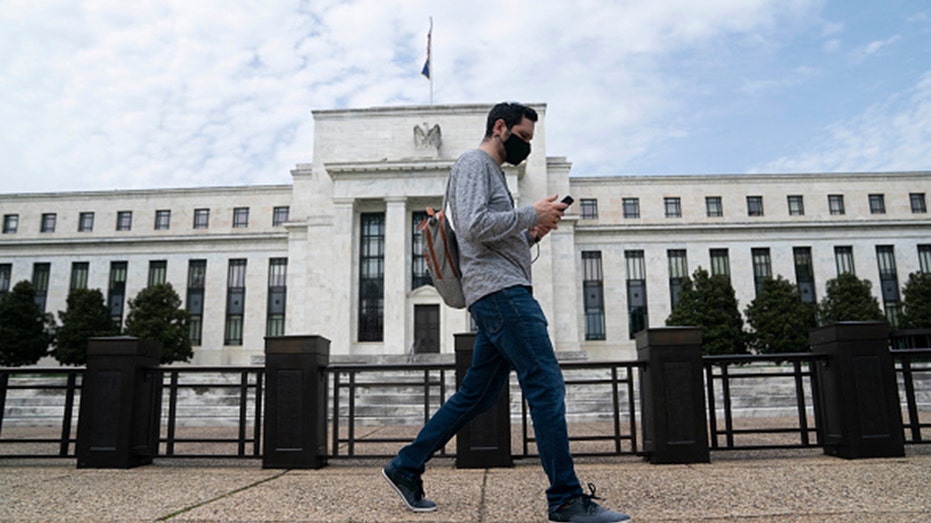How the Federal Reserve missed the mark on surging inflation
Fed expected to chart aggressive course toward tackling inflation
It's Powell's job to say we're going to have a soft landing: Booth
Danielle DiMartino Booth and Joseph Lavorgna react to the Fed chair's recent comments on 'Making Money.'
For most of 2021, Federal Reserve Chairman Jerome Powell stuck to a mantra that surging inflation was transitory and likely to fade as supply bottlenecks dissipated.
But Powell has pivoted sharply since then, transforming into a policy hawk in the months since he conceded that rising prices had proven to be more powerful and persistent than initially expected. With inflation soaring to a new 40-year high in March, the U.S. central bank is under mounting pressure to move more aggressively to cool demand and slow surging consumer prices.
ONE OF BIDEN'S FAVORITE ECONOMISTS SEES A HIGH CHANCE OF RECESSION IN NEXT 2 YEARS
Central bank policymakers raised rates by a quarter-percentage point in March, but are almost certain to approve a steeper, half-percentage point hike at the conclusion of their two-day meeting on Wednesday. It would mark the fastest rate increase since 2000. Many traders believe the Fed will hike rates by another half-point in June, and possibly July too, as they race to catch up with inflation.
On top of that, the Fed will likely begin shrinking its nearly $9 trillion balance sheet, a move that will further tighten credit for U.S. households. Minutes from the Fed's March meeting suggest the central bank will begin unwinding at a maximum monthly pace of $60 billion in Treasurys and $35 billion in mortgage-backed securities.
By comparison, one year ago, when inflation was just starting to rise above the Fed's 2% objective, policymakers projected that they would not raise interest rates until at least 2024.
"I think even they would acknowledge that they acted too late to tighten their posture," Curt Long, the chief economist and vice president of research at the National Association of Federally Insured Credit Unions, told FOX Business. "So they certainly made a mistake failing to act before they did."
There are likely two reasons the Fed missed the signs of sky-high inflation, according to Long: First, policymakers were largely operating under the assumption that higher prices were narrowly related to the COVID-19 pandemic, and that once virus cases started to decline, there would be accompanying reductions in price growth.
But the root cause of inflation was multipronged, with higher prices stemming from supply chain disruptions, high consumer demand, the Russian war in Ukraine and trillions in government spending that went directly into the pockets of Americans. When inflation did not fall along with virus cases – and once wages began rapidly rising – the Fed was forced to switch course.

A man wearing a mask walks past the U.S. Federal Reserve building in Washington D.C., the United States, on April 29, 2020. ((Xinhua/Liu Jie via Getty Images) / Getty Images)
On top of that, Fed officials may have been haunted by past policy mistakes: In the wake of the 2008 financial crisis, for instance, the central bank confronted persistently low inflation well below its target of 2%.
"The other thing to keep in mind is, really from a broader sense, the 10 years following the financial crisis, where the Fed was persistently below their inflation target almost over that entire period," Long said. "And so I think not wanting to repeat potentially mistakes that had been made previously, they were in a very dovish posture coming into the pandemic."
Now, Fed policymakers are counting on finding that elusive sweet spot between curbing inflation and preserving economic growth, even though history shows that the U.S. central bank often struggles to successfully thread the needle between those frequently contrasting goals.
Median projections show that central bank officials are confident they can engineer such a landing: They anticipate core inflation falling to 4.1% at the end of the year, 2.4% next year and 2.3% in 2024, while they believe unemployment will hold steady at 3.5% to 3.6% for some time.
"It is worth noting that today the economy is very strong and is well-positioned to handle tighter monetary policy," Powell said during a speech in March.

In this Jan. 29, 2020 file photo, Federal Reserve Chair Jerome Powell pauses during a news conference in Washington. (AP Photo/Manuel Balce Ceneta, File / AP Newsroom)
Despite that, there are growing fears on Wall Street that the Federal Reserve could inadvertently send the economy into a recession as it takes a more aggressive approach to fighting inflation, which is at the highest level since December 1981. Goldman Sachs, Deutsche Bank and Bank of America are among the firms forecasting a downturn in the next two years.
"The window for the Fed to engineer a soft landing has likely closed, since the economy is already starting to deteriorate before the bulk of the Fed's inflation-fighting tightening actions have taken place," said Danielle DiMartino Booth, CEO and chief strategist at Quill Intelligence and a former adviser to a previous Dallas Fed president. "The last economic pillar standing is the job market, but we’re already seeing a weakening in new job postings."
GET FOX BUSINESS ON THE GO BY CLICKING HERE
Powell has pushed back against concerns that further tightening by the central bank will trigger a recession and has maintained optimism that the Fed can strike a delicate balance between taming inflation without crushing the economy. Still, he has acknowledged the difficulty of the task ahead and said it is "absolutely essential" for central bankers to restore price stability.
"Our goal is to use our tools to get demand and supply back in sync, so inflation moves back into place, without a slowdown that amounts to a recession," Powell said. "I don't think you'll hear anyone at the Fed say that's straightforward and easy. It's going to be challenging."





















